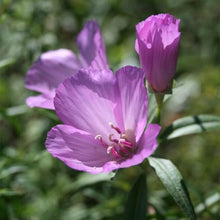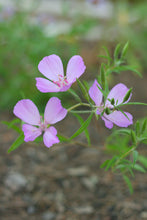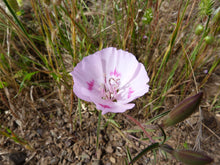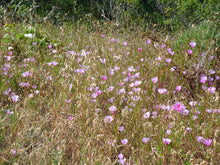
Clarkia amoena
As the Latin name suggests (“amoena” meaning charming or pleasing), farewell-to-spring is a spectacularly showy addition to native gardens and wildflower meadows. This annual wildflower boasts pink, cup-shaped flowers with long bloom times that provide pollen and nectar for native bees and butterflies after other plants have gone dormant.
- Plant type/canopy layer: deciduous, annual (self-sowing), herbaceous plant
- Size at maturity: 24"-36" tall, 12"-18" wide
- Light requirements: full sun, part sun/part shade
- Moisture requirements: dry to moist soil, prefers well-drained
- Bloom time: June - August
- Growth rate/ease: moderate growth rate, easy to grow
- Wildlife support: flowers attract and support honey bees, native bumblebees, mason bees, leaf-cutter bees, and butterflies
- Native habitat/range: common in meadows, vernal wetlands, and coastal areas from the Pacific coastline eastward into the lower Cascades, from British Columbia to California. Portland Plant List - yes.
- Special features & uses: hummingbird favorite; landscape uses include pollinator gardeners and meadowscapes
Gardening with Farewell-to-Spring: This beautiful wildflower prefers fully to mostly sunny sites with well-drained soil of average fertility. Although it is an annual, it will readily reseed itself if planted in a favorable location. Overseed according to the direction below into bare patches of your meadowscapes, or as a stunning filler between other perennial such as foothill sedge, blanketflower, penstemons, mule's ear or Oregon sunshine.
Seed Packet Contains: approximately 550 seeds
When and How to Sow Seeds: Sow seed between September and November (ideally) or in March. Cooler fall/early spring temps and seasonal rains will enhance germination and promote the best growth. If you miss the fall and early spring planting windows, you can still plant in April or May, but plan to water more during the drought to encourage strong growth and blooms the first year. Spring-sown plants may be smaller in stature than fall-sown when they bloom.
Scatter seeds at a rate of 60 seeds/sq ft on loose-weed free soil. Alternatively, you can seed a small "pinch" per situ or a small "pinch" per pot. Sowing in situ vs. pots tends to produce sturdier, more robust plants.
Lightly rake the seeds in to increase seed-to-soil contact, but be careful not to cover the seed with more than 1/4" soil. Best germination will occur with seeds sitting directly on the surface.
Photo Credit 1: Willamette Wildlings
Photo Credit 2: Karli Del Biondo, Beetles and Bees
Photo Credit 3 & 4: "Clarkia amoena" by StephanieFalzone is licensed under CC BY 2.0







